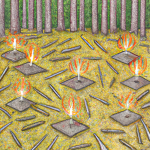Advanced Knot Tying: Essential Skills for Survival Situations
In a survival situation, having the right skills can mean the difference between life and death. One skill that often goes overlooked is knot tying. While basic knots are useful in everyday situations, advanced knots can be invaluable in survival scenarios. They can be the lifeline that keeps you safe and allows you to navigate through challenging terrains, secure shelter, and even catch food. In this article, we will explore some advanced knots, their uses, and how to tie them.
1. Bowline Knot
The bowline knot is known for its strength and stability. It creates a fixed loop that will not slip or come undone under tension. This makes it ideal for securing shelters, creating pulley systems, and even performing rescues. To tie a bowline knot:
- Create a small loop in the rope, leaving enough slack to work with.
- Pass the end of the rope through the loop from underneath and around the standing part of the rope.
- Bring the end of the rope back down through the loop.
- Tighten the knot by pulling on the standing part of the rope and the end of the rope simultaneously.
2. clove hitch
The clove hitch is a versatile knot that can be used to secure objects to a fixed point such as a tree or pole. It is quick and easy to tie and untie, making it useful for a variety of purposes. To tie a clove hitch:
- Pass the rope over the object you are securing.
- Cross the rope over itself.
- Pass the rope over the object again, creating an “X” shape.
- Tuck the end of the rope under the second crossing and tighten the knot.
3. Prusik Knot
The Prusik knot is an essential knot for climbers and survivalists. It is commonly used to create friction on a rope, allowing you to ascend or descend safely. This knot is particularly useful in situations where you need to create mechanical advantage or when scaling steep inclines. To tie a Prusik knot:
- Create a loop with a separate piece of rope.
- Wrap the loop around the main rope, making three full wraps.
- Pass the end of the loop through itself, creating a girth hitch.
- Tighten the knot by pulling on the ends of the rope.
4. Figure 8 Knot
The figure 8 knot is another strong and secure knot that is commonly used in rock climbing and rappelling. It creates a stopper knot that prevents rope from slipping through a loop or belay device. To tie a figure 8 knot:
- Form a small loop in the rope.
- Loop the end of the rope around and behind the standing part of the rope.
- Pass the end of the rope through the small loop and tighten.
- Tighten the knot by pulling on the standing part of the rope and the end of the rope.
Practicing these knots regularly and familiarizing yourself with their uses will prepare you for unforeseen circumstances. Remember, in a survival situation, your life may depend on your ability to secure shelter, rappel down a cliff, or extract yourself from dangerous situations. Don’t wait until it’s too late to acquire these essential skills.




GIPHY App Key not set. Please check settings